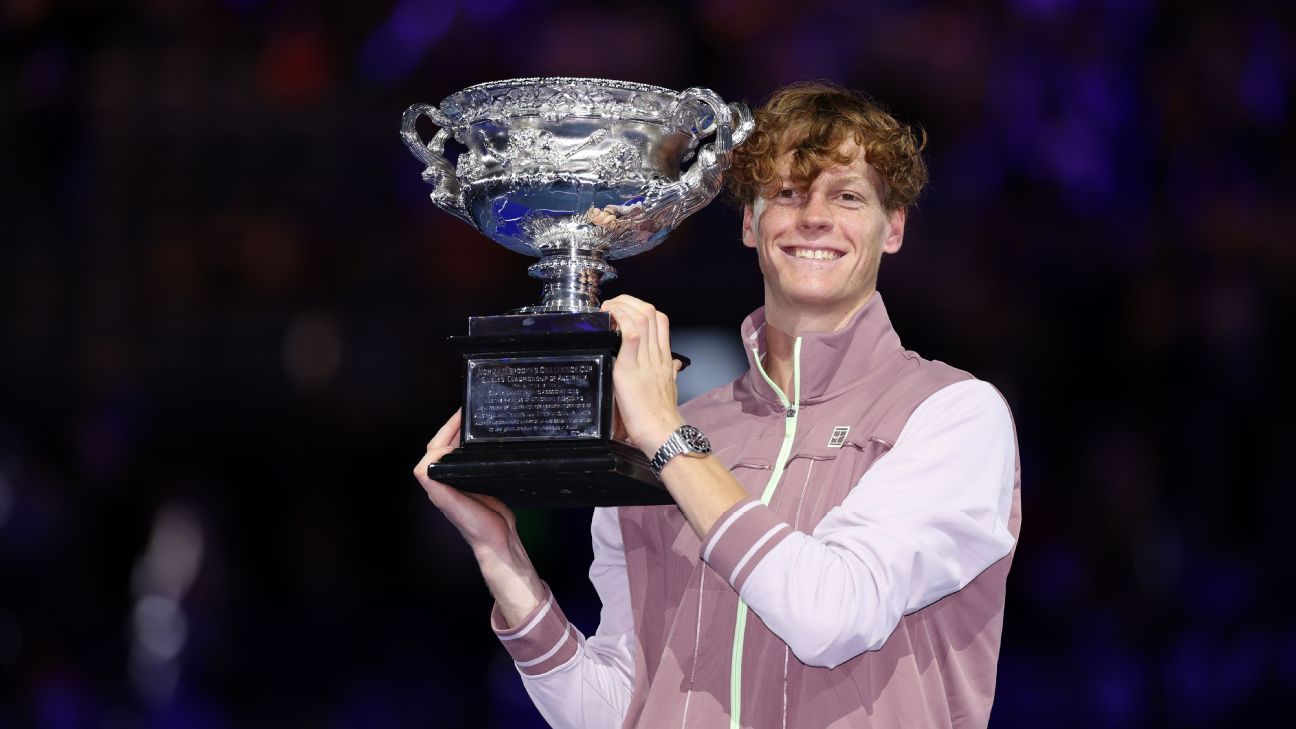MELBOURNE, Australia — For close to two decades, world No. 1 Novak Djokovic has showcased the blueprint for Australian Open success.
It’s been a combination of efficient, precise serving, error-free rallying and spirit-crushing defense, the ability to retrieve ball after ball — and then some. Add in the uncanny knack of being able to produce otherworldly tennis in the pressure moments, as well as just a pinch of adversity, and you’ve got an amalgamation of tennis excellence that’s led Djokovic to a record 10 titles at Melbourne Park.
The Djokovic recipe for success is no secret, but try as they might, nobody else had managed to grasp the concept and check every one of those boxes throughout the marathon two-week event. At least until now.
Jannik Sinner‘s run to the Australian Open title was reminiscent of many of those successful Djokovic campaigns. There were extended periods of dominance. There were nerves of steel. And in the final against Daniil Medvedev, there’s no denying there was adversity, Sinner having to fight and scrap from two sets down to clinch his first major title 3-6, 3-6, 6-4, 6-4, 6-3.
Sinner finished the tournament as he started it — striking the ball with confidence from behind the baseline with almost robotic precision. On championship point, he rocketed a forehand down the line, landing it inches inside the baseline before falling to the court in jubilation.
“The process and the hard work occasionally pays off,” Sinner told reporters after the final. “Sitting here, with this trophy now, watching it, I still have to realize it, because it’s one of the biggest trophies we have in our sport.”
Sunday’s final punctuated a remarkable fortnight of tennis for the 22-year-old Italian, but it was a match that proved a totally different proposition to anything else he had encountered this tournament.
It was evident Sinner was suffering from nerves early in the contest. The errors he hadn’t made all tournament began creeping in and Medvedev, the tournament’s iron man who set a record for most minutes and sets played at a Grand Slam, was playing the most aggressive tennis of his career.
The game plan Medvedev brought into the final was clear: Keep the points short. He crushed ball after ball, finding angles that defied geometry and left Sinner scrambling for answers. It was high-risk, high-reward tennis, and it resulted in a two-sets-to-love lead after just 85 minutes.
But the hole Sinner dug himself seemed to provide some sort of freedom. And the more he warmed into the match, the more Medvedev began to fade. The powerful passing shots Medvedev had been making began to dry up, and the unforced error count grew. Meanwhile, it was Sinner playing that familiar Djokovic role of not forcing anything and letting his opponent beat himself. He also seized the key moments down the stretch and after 3 hours and 44 minutes the comeback was complete, Sinner becoming the second-youngest player to overcome such a deficit in a Slam final.
“I had this feeling that he might come out a little bit more aggressive,” Sinner said of Medvedev’s approach to the final. “He played really, really well for the first two-and-a-half sets. I just tried to stay positive. I tried just to play even level and just stay as long in the court as possible, knowing that he has spent so many hours on the court. The more the match goes on, maybe physically I’m a little bit better today.
“When you win one very important game, the match can change occasionally, and that was the case today.”
Sinner had been near flawless in the lead-up to his showdown with Medvedev. He barely broke a sweat in his first two matches, and only looked more dominant from the third round onwards when seeded opponents began coming his way.
The first was Argentine Sebastian Baez, who managed to pinch just four games off him. Then it was last year’s semifinalist, Karen Khachanov, before world No. 5 Andrey Rublev. One by one he dispatched them without dropping a set.
His fiercest test was always going to be Djokovic in the semifinals, the pair having been on a collision course to meet in the last four from the moment the draw was unveiled.
And while there may not be anything more daunting in the sport than standing opposite Djokovic at Rod Laver Arena, Sinner didn’t wilt under the Melbourne sun or shy away from the occasion. Instead, he stared down the 24-time major champion and produced a performance that left the King of Melbourne Park mystified, handing him his first defeat at the tournament in six years.
Sinner had given adequate warning he was destined for greatness in 2024.
His breakthrough at Wimbledon last year, in which he reached the semifinals, seemed to not only unlock a new level in his game but offer newfound confidence that he could challenge for the biggest prizes in the sport. In the months that followed, Sinner climbed into the world’s top four and won his maiden Masters 1000 title in Toronto.
He closed the season in scintillating fashion, finishing runner-up to Djokovic at the ATP Finals, before leading Italy to Davis Cup glory. Now, he’s the Australian Open champion.
Since that defeat at Wimbledon last July, Sinner has lost just four matches. He’s also bested the world No. 1 and 3 in the space of three days, proving it’s not just Carlos Alcaraz leading the next wave of tennis talent.
“He doesn’t miss much, and that’s why he has a Grand Slam, why he has a lot of titles and why he’s winning a lot of matches,” Medvedev said of Sinner. “I would think he’s top three, top five, on tour. Maybe top one.”
